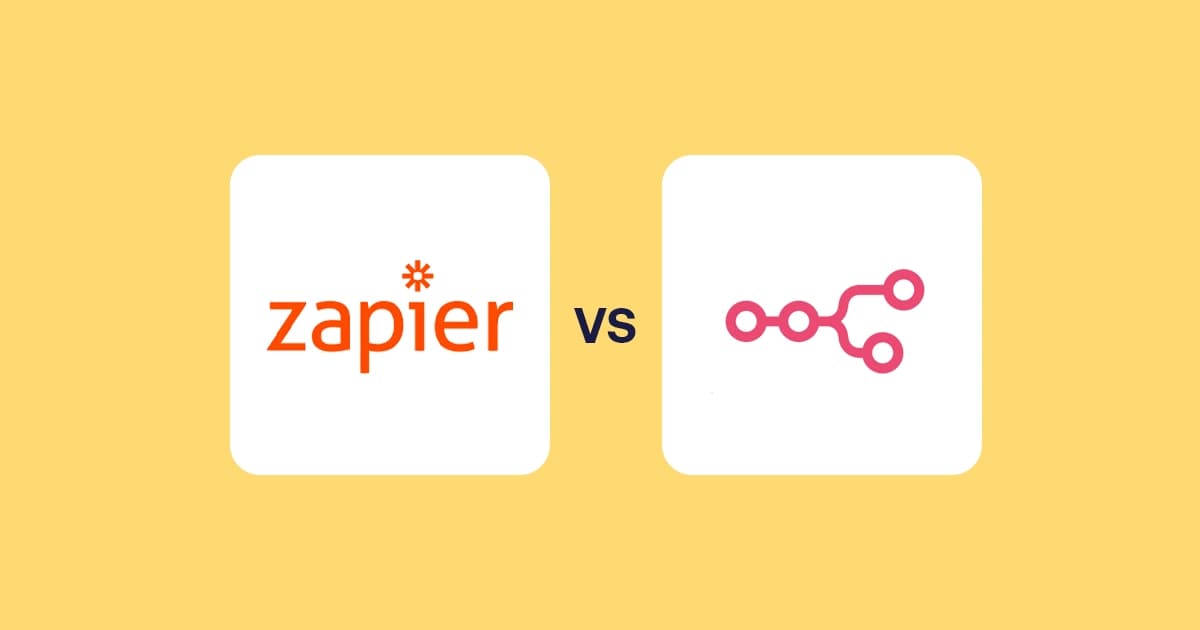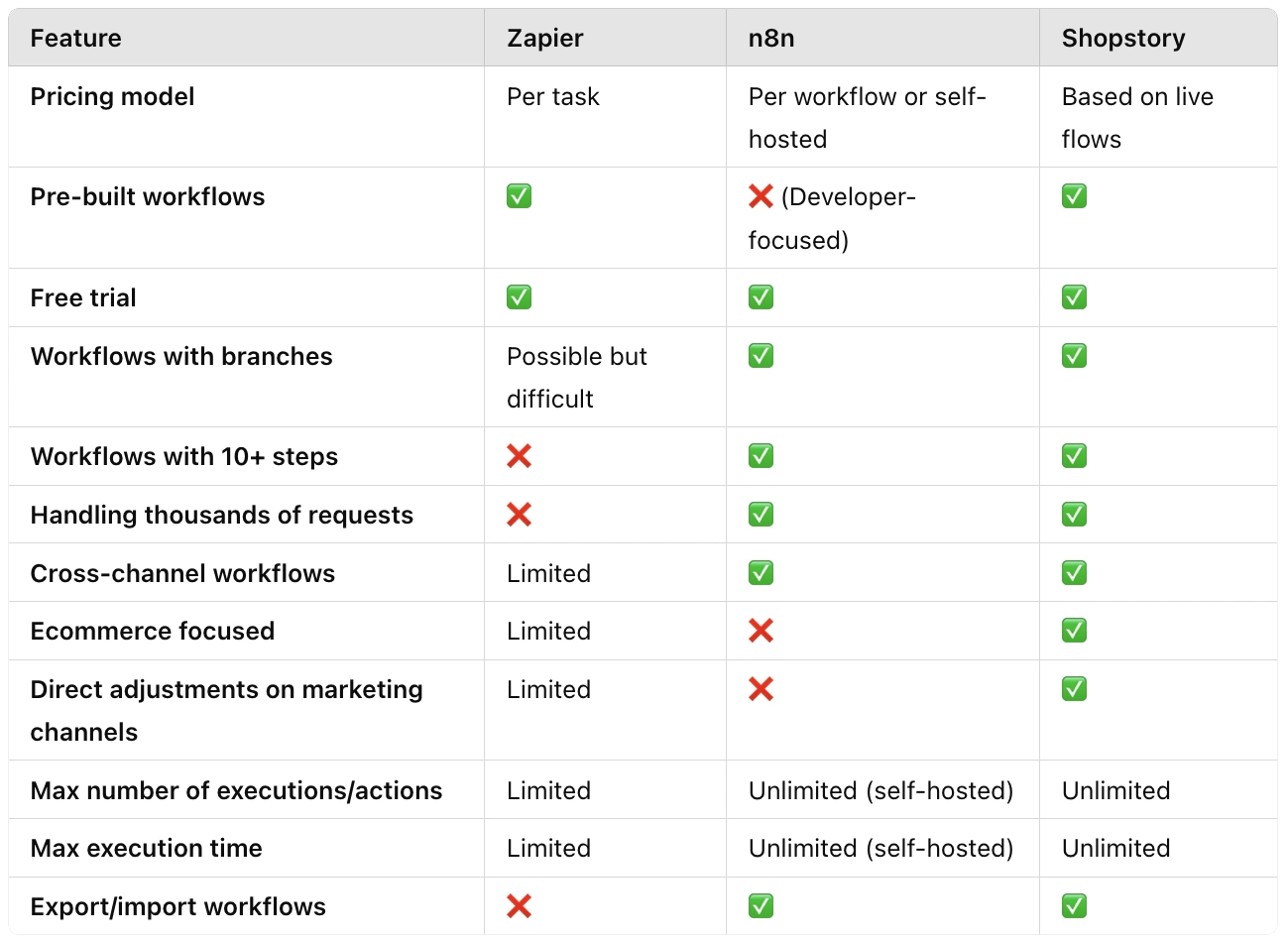MARKETING AUTOMATITON
Zapier vs n8n (and why Shopstory is better)
18.09.2024

Are you comparing Zapier vs n8n to make a decision on what to use for your ecommerce and performance marketing automations? Both platforms offer powerful automation solutions, but they have different approaches. In this article, we compare their features, pricing, and usability. At the end, we show you why Shopstory might be an even better choice – especially for online stores and marketers.
Zapier has long been a dominant player in the automation tools space, known for its wide range of integrations and user-friendly interface. n8n, on the other hand, has established itself as a powerful open-source alternative that appeals primarily to tech-savvy users who want full control and flexibility in their workflows. But which tool is right for you? Let's take a closer look at both platforms.
TL;DR
Zapier is ideal for beginners who need quick and easy automations, while n8n offers more flexibility and control for advanced users. Both tools have their strengths, but if you are looking for a platform that is specifically tailored to the needs of ecommerce and performance marketing, Shopstory is the better choice. Not only does it offer deep, native integrations, but it also enables complex workflows without programming knowledge – perfect for growing businesses.

A head-to-head comparison of Zapier vs n8n (vs Shopstory)
Zapier vs n8n: a comprehensive comparison
1. Pricing
Zapier: Zapier offers a free version, but it is limited to 100 tasks per month and a maximum of five workflows (zaps). To automate more tasks, you need to upgrade to paid plans, which can quickly increase in price depending on the number of tasks. Each step in a workflow counts as a task, which significantly increases costs as your automation grows.
- Free plan: 100 tasks per month, maximum of 5 workflows.
- Paid plans: Start at $19.99/month for 750 tasks, and costs quickly increase with high task volumes.
n8n: n8n has a different pricing model because it is an open-source platform. This means you can use n8n for free if you host it on your own server. For organizations that don't want to manage their own infrastructure, n8n offers a hosted cloud solution with pricing that varies based on the number of active workflows and data volume. The open-source nature of n8n makes it particularly attractive for tech-savvy users who want to minimize costs while enjoying maximum flexibility.
- Free plan (self-hosted): Unlimited tasks and workflows if you host it yourself.
- Cloud service: Starting at €20/month for up to 5 active workflows and 5,000 executable steps.
Verdict: Zapier offers a simple pricing structure, but it can get expensive as your automations grow more extensive. n8n is more flexible and can be significantly cheaper if you self-host. The choice depends on your technical skills and budget.
2. Ease of use
Zapier: Zapier is known for its intuitive interface and is primarily aimed at users who want to set up automations without any prior technical knowledge. With a drag-and-drop editor, you can quickly create simple workflows. The biggest advantage of Zapier is that it is designed so that even beginners without technical know-how can create automations within minutes. The step-by-step instructions and the large library of ready-made templates make it easy to get started.
n8n: n8n also offers a visual interface, but it is more sophisticated. It displays workflows in a flowchart layout that allows for a graphical representation of complex processes. The platform is aimed more at technically adept users, as it offers more control and customization options. Although no programming knowledge is required, it helps to have a basic understanding of automations and APIs. For beginners, n8n might seem overwhelming at first, but its advanced functionality makes it a powerful solution for more complex needs.
Conclusion: Zapier is the better choice for beginners and users who want to quickly create simple automations. n8n offers more flexibility but requires a steeper learning curve and is more suitable for tech-savvy users who want to create more complex workflows.
3. Integrations
Zapier: Zapier is known for its huge selection of integrations. With over 5,000 supported apps, Zapier offers one of the largest libraries of integrations on the market. These include popular tools like Shopify, Google Ads, Meta Ads, Salesforce, and many more. This extensive selection makes Zapier particularly attractive for companies that need to integrate a wide range of apps into their workflows.
n8n: n8n offers a smaller number of pre-built integrations, but its open-source nature makes it extremely flexible. You can integrate almost any app with n8n through its API. n8n is particularly advantageous for developers and tech-savvy users because it offers extensive control over API calls and allows you to create your own custom integrations.
Bottom line: Zapier offers a more extensive library of out-of-the-box integrations, making it more attractive for companies with many tools. n8n is ideal for users who want to create their own integrations or have more control over API-based workflows.
4. Complex workflows and error handling
Zapier: Zapier is great for simple and medium-sized automations. However, as soon as you need more complex workflows with multiple branches, conditional logic, and loops, Zapier reaches its limits. While Zapier's “Path” function allows for simple branching, it's not as flexible as n8n's flowchart logic. Error handling in Zapier is also relatively limited, and error reports can be vague, making troubleshooting more difficult.
n8n: n8n excels when it comes to creating complex workflows. With its flowchart interface, you can create workflows with multiple conditions, loops, and branches. n8n also offers advanced error handling capabilities that provide detailed information about any issues that arise and allow you to fix problems directly in the workflow. You can create custom error paths and implement advanced logic to ensure that your workflow remains stable even when errors occur.
Conclusion: n8n is the better choice for complex automations and detailed error handling. Zapier is more suitable for simpler workflows with little potential for error.
5. Error management and performance
Zapier: Zapier offers basic error handling mechanisms. The platform automatically detects when a workflow fails and notifies the user. However, error diagnostics are often inaccurate, and users have to test their way through the cause of the error. For particularly complex workflows, this can quickly become cumbersome and time-consuming.
n8n: n8n offers much more sophisticated error handling than Zapier. With options like ignore, continue, and rollback, you can customize how your workflow responds to errors. This advanced error handling is crucial, especially for large and complex workflows, to ensure that your system remains stable even under adverse conditions.
Conclusion: If you need a reliable error handling mechanism, n8n is the superior solution. Zapier is suitable for simple automations, but has its limitations when it comes to error management.
Zapier vs n8n (vs Shopstory) - The better alternative for ecommerce and marketing automation
While both Zapier and n8n are powerful tools for general automations, Shopstory offers a solution specifically tailored for ecommerce and performance marketing. Here are some of the key reasons why Shopstory is the better choice for online stores and marketing agencies:
- Deep integrations for ecommerce and marketing:
Shopstory offers native, purpose-built integrations for the leading shopping cart systems like Shopify, WooCommerce, Shopware and marketing tools like Google Ads, Meta Ads. These integrations go far beyond Zapier or n8n API integrations, allowing you to create deep automations that are directly aligned with ecommerce and performance marketing needs. - Pricing and scalability:
Unlike Zapier, which can get expensive as your automations get more extensive, and n8n, which is cheap but technically demanding, Shopstory offers usage-based billing with no hidden costs per task. Whether you create simple or complex workflows, you only pay for the workflows you activate. - Ease of use with maximum flexibility:
Shopstory combines the ease of use of Zapier with the flexibility and complexity of n8n. The drag-and-drop interface allows even non-technical users to create and customize complex workflows. This way, you can automate bidding strategies, optimize campaigns, or create cross-channel reports – all without any programming knowledge. - Error Handling and Customer Support:
Shopstory offers transparent error handling with an inspector tool that provides detailed error messages and clear instructions for how to fix them. There is also a customer support team to help you solve technical issues, a feature that is often limited on other platforms. - Marketing-specific workflows:
Shopstory was built with the needs of performance marketing teams in mind. From automating bidding strategies to keyword optimization and comprehensive multi-channel reporting, Shopstory allows you to fully automate and optimize marketing processes.
Get Started for Free
Shopstory offers a freemium model where users can start with a free flow forever, giving businesses the flexibility to explore all the platform’s features before committing to a paid plan. This is perfect for businesses that want to test-drive Shopstory’s powerful ecommerce and marketing automation without any upfront cost.
Zapier vs n8n - Our Conclusion
The Zapier vs n8n comparison has many angles. Zapier is ideal for simple automations and quick integrations, while n8n is particularly attractive for tech-savvy users who want to create complex workflows with extensive control and error handling. Both tools are strong, but have their limitations. However, if you are looking for a platform specifically designed for ecommerce and performance marketing automation, Shopstory is your best bet. With deep integrations, flexible workflows, and an unbeatable price-performance ratio, Shopstory enables you to take your automations to the next level – ideal for growing online stores and marketing teams.
Try Shopstory for FREE and see how it can supercharge your business’s automation efforts.
More to Explore
Discover more insights from our latest articles
© 2025, Shopstory









